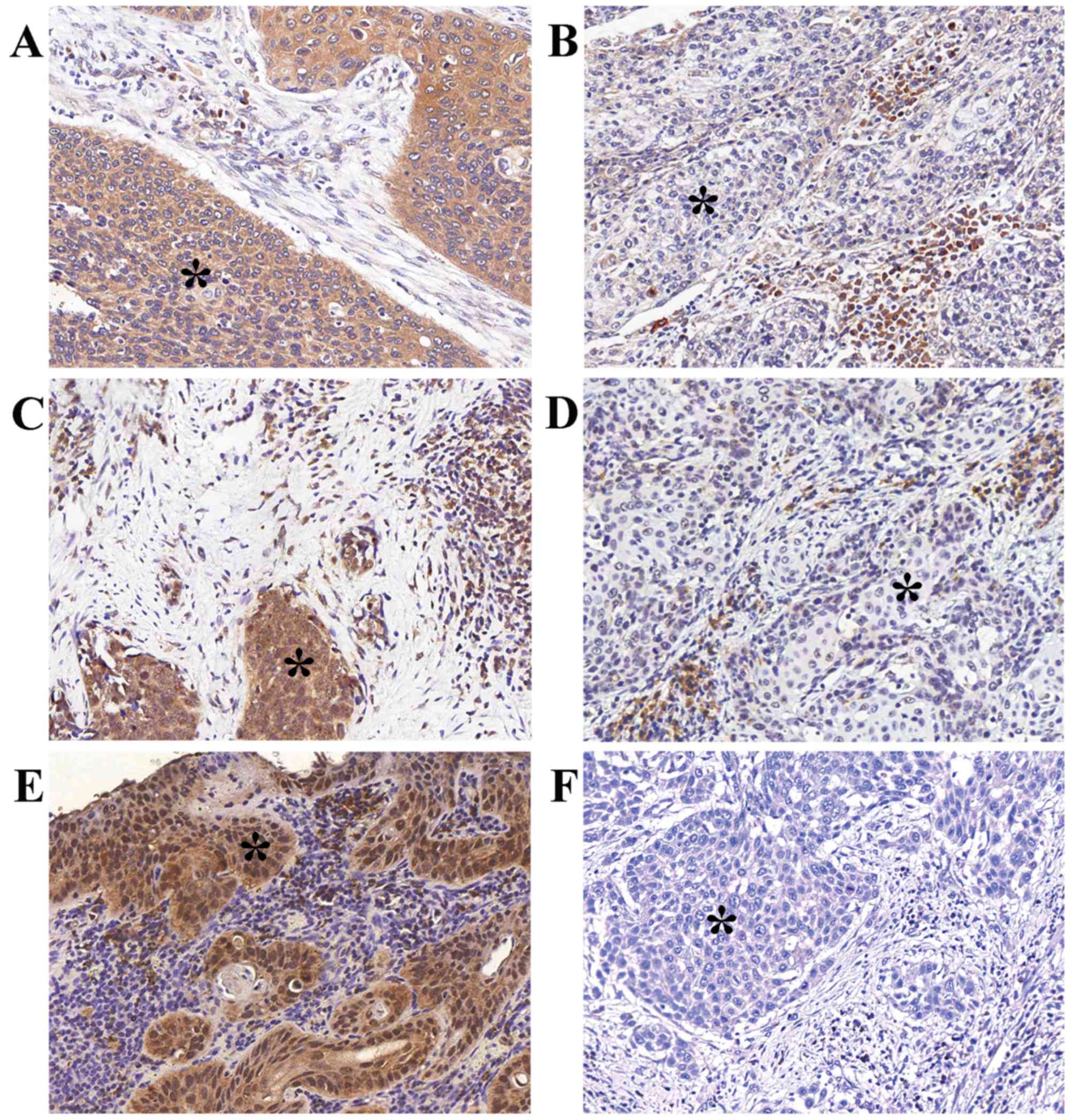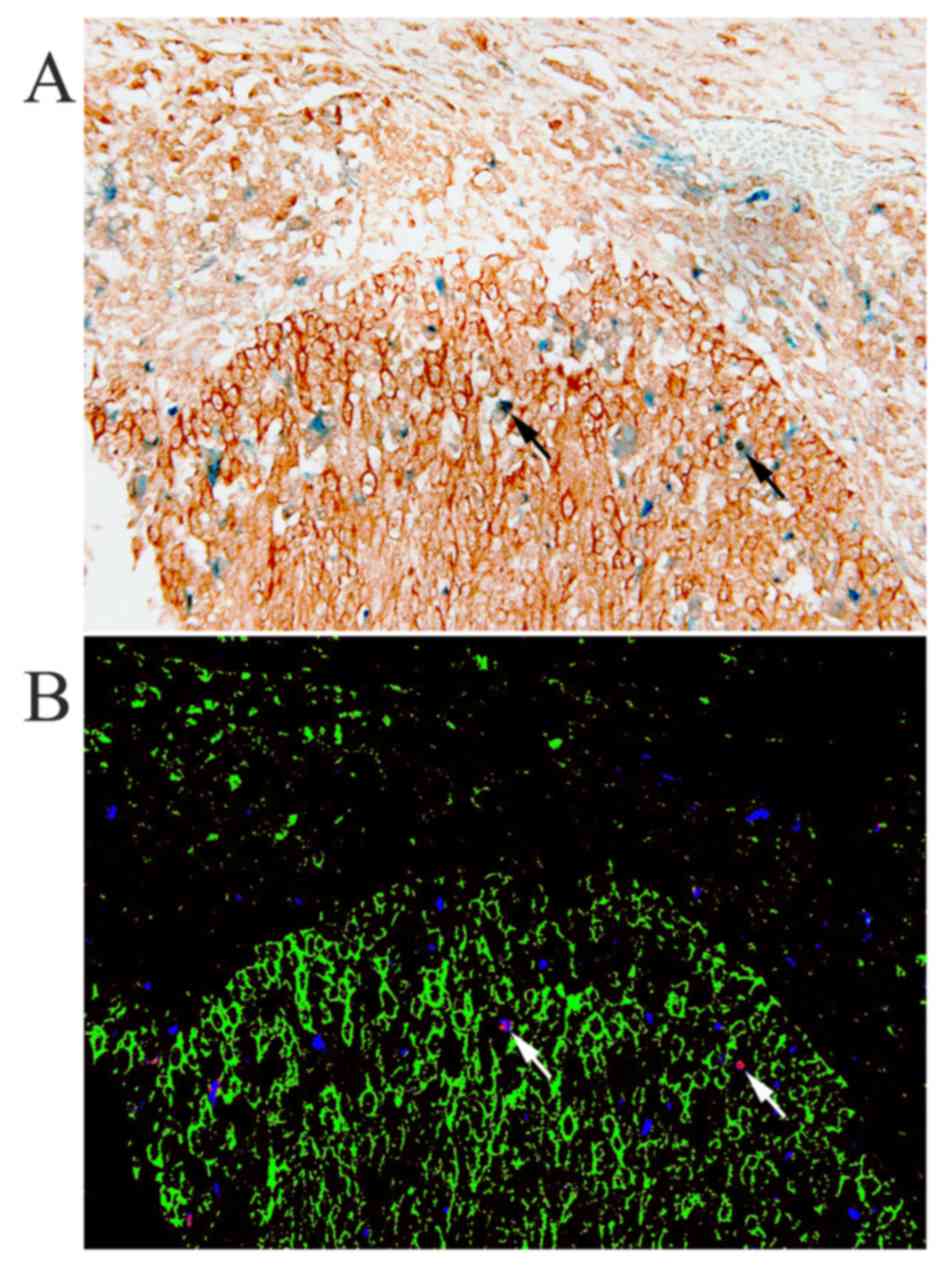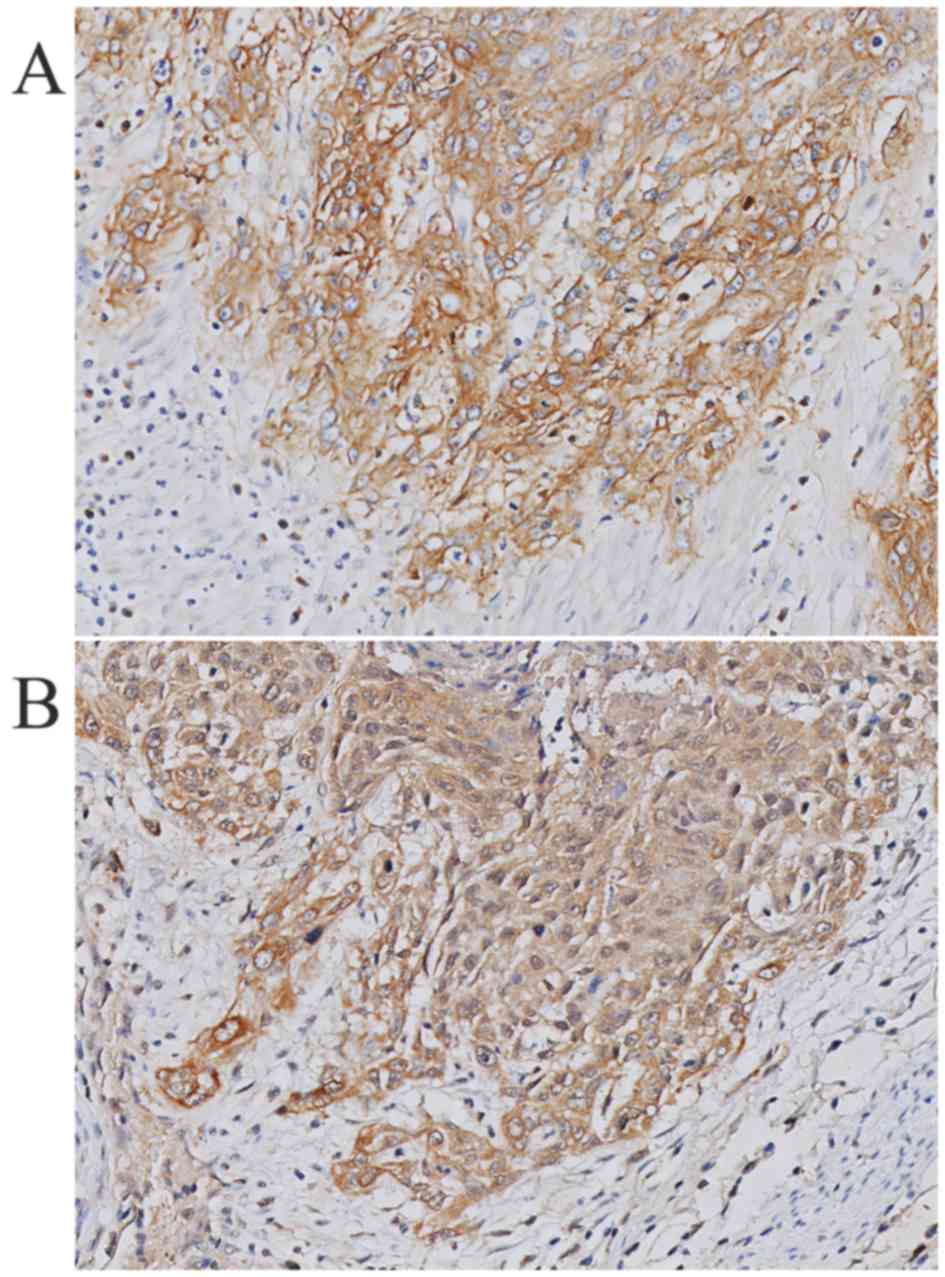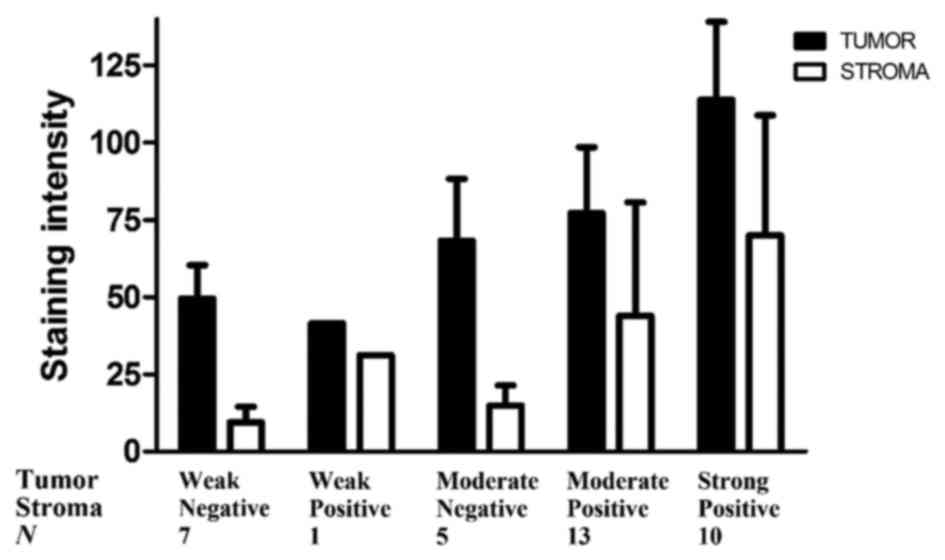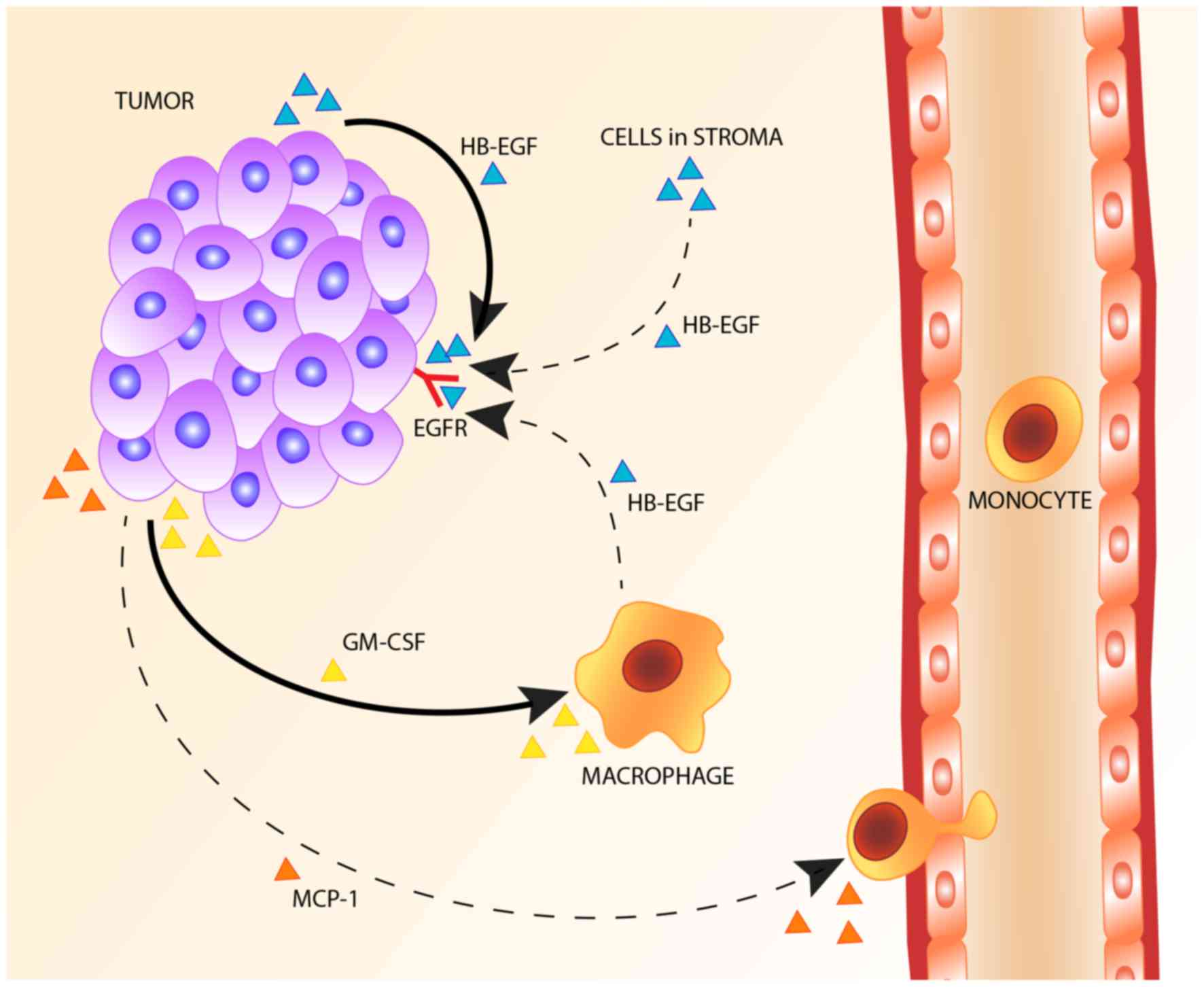|
1
|
Torre LA, Bray F, Siegel RL, Ferlay J,
Lortet-Tieulent J and Jemal A: Global cancer statistics, 2012. CA
Cancer J Clin. 65:87–108. 2015. View Article : Google Scholar : PubMed/NCBI
|
|
2
|
Walboomers JM, Jacobs MV, Manos MM, Bosch
FX, Kummer JA, Shah KV, Snijders PJ, Peto J, Meijer CJ and Muñoz N:
Human papillomavirus is a necessary cause of invasive cervical
cancer worldwide. J Pathol. 189:12–19. 1999. View Article : Google Scholar : PubMed/NCBI
|
|
3
|
de Martel C, Ferlay J, Franceschi S,
Vignat J, Bray F, Forman D and Plummer M: Global burden of cancers
attributable to infections in 2008: A review and synthetic
analysis. Lancet Oncol. 13:607–615. 2012. View Article : Google Scholar : PubMed/NCBI
|
|
4
|
Joura EA, Ault KA, Bosch FX, Brown D,
Cuzick J, Ferris D, Garland SM, Giuliano AR, Hernandez-Avila M, Huh
W, et al: Attribution of 12 high-risk human papillomavirus
genotypes to infection and cervical disease. Cancer Epidemiol
Biomarkers Prev. 23:1997–2008. 2014. View Article : Google Scholar : PubMed/NCBI
|
|
5
|
Koutsky L: Epidemiology of genital human
papillomavirus infection. Am J Med. 102A:3–8. 1997. View Article : Google Scholar
|
|
6
|
Utrera-Barillas D, Castro-Manrreza M,
Castellanos E, Gutiérrez-Rodríguez M, Arciniega-Ruíz de Esparza O,
García-Cebada J, Velazquez JR, Flores-Reséndiz D,
Hernández-Hernández D and Benítez-Bribiesca L: The role of
macrophages and mast cells in lymphangiogenesis and angiogenesis in
cervical carcinogenesis. Exp Mol Pathol. 89:190–196. 2010.
View Article : Google Scholar : PubMed/NCBI
|
|
7
|
Boccardo E, Lepique AP and Villa LL: The
role of inflammation in HPV carcinogenesis. Carcinogenesis.
31:1905–1912. 2010. View Article : Google Scholar : PubMed/NCBI
|
|
8
|
Lepique AP, Daghastanli KR, Cuccovia IM
and Villa LL: HPV 16 tumor associated macrophages suppress
antitumor T cell responses. Clin Cancer Res. 15:4391–4400. 2009.
View Article : Google Scholar : PubMed/NCBI
|
|
9
|
Mantovani A, Germano G, Marchesi F,
Locatelli M and Biswas SK: Cancer-promoting tumor-associated
macrophages: New vistas and open questions. Eur J Immunol.
41:2522–2525. 2011. View Article : Google Scholar : PubMed/NCBI
|
|
10
|
Mantovani A and Sica A: Macrophages,
innate immunity and cancer: Balance, tolerance, and diversity. Curr
Opin Immunol. 22:231–237. 2010. View Article : Google Scholar : PubMed/NCBI
|
|
11
|
de Vos van Steenwijk PJ, Ramwadhdoebe TH,
Goedemans R, Doorduijn EM, van Ham JJ, Gorter A, van Hall T,
Kuijjer ML, van Poelgeest MI, van der Burg SH, et al:
Tumor-infiltrating CD14-positive myeloid cells and CD8-positive
T-cells prolong survival in patients with cervical carcinoma. Int J
Cancer. 133:2884–2894. 2013.PubMed/NCBI
|
|
12
|
Fujimoto J, Sakaguchi H, Aoki I and Tamaya
T: Clinical implications of expression of interleukin 8 related to
angiogenesis in uterine cervical cancers. Cancer Res. 60:2632–2635.
2000.PubMed/NCBI
|
|
13
|
Pollard JW: Tumour-educated macrophages
promote tumour progression and metastasis. Nat Rev Cancer. 4:71–78.
2004. View
Article : Google Scholar : PubMed/NCBI
|
|
14
|
Petrillo M, Zannoni GF, Martinelli E,
Pedone Anchora L, Ferrandina G, Tropeano G, Fagotti A and Scambia
G: Polarisation of tumor-associated macrophages toward M2 phenotype
correlates with poor response to chemoradiation and reduced
Survival in patients with locally advanced cervical cancer. PLoS
One. 10:e01366542015. View Article : Google Scholar : PubMed/NCBI
|
|
15
|
Gong W, Xiao Y, Wei Z, Yuan Y, Qiu M, Sun
C, Zeng X, Liang X, Feng M and Chen Q: Toward the use of precision
medicine for the treatment of head and neck squamous cell
carcinoma. Oncotarget. 8:2141–2152. 2017.
|
|
16
|
Heinemann V, von Weikersthal LF, Decker T,
Kiani A, Vehling-Kaiser U, Al-Batran SE, Heintges T, Lerchenmüller
C, Kahl C, Seipelt G, et al: FOLFIRI plus cetuximab versus FOLFIRI
plus bevacizumab as first-line treatment for patients with
metastatic colorectal cancer (FIRE-3): A randomised, open-label,
phase 3 trial. Lancet Oncol. 15:1065–1075. 2014. View Article : Google Scholar : PubMed/NCBI
|
|
17
|
Greenhalgh J, Dwan K, Boland A, Bates V,
Vecchio F, Dundar Y, Jain P and Green JA: First-line treatment of
advanced epidermal growth factor receptor (EGFR) mutation positive
non-squamous non-small cell lung cancer. Cochrane Database Syst
Rev. 5:CD0103832016.
|
|
18
|
Schrevel M, Gorter A, Kolkman-Uljee SM,
Trimbos JB, Fleuren GJ and Jordanova ES: Molecular mechanisms of
epidermal growth factor receptor overexpression in patients with
cervical cancer. Mod Pathol. 24:720–728. 2011. View Article : Google Scholar : PubMed/NCBI
|
|
19
|
Narayanan R, Kim HN, Narayanan NK, Nargi D
and Narayanan B: Epidermal growth factor-stimulated human cervical
cancer cell growth is associated with EGFR and cyclin D1
activation, independent of COX-2 expression levels. Int J Oncol.
40:13–20. 2012.
|
|
20
|
Reyes HD, Thiel KW, Carlson MJ, Meng X,
Yang S, Stephan JM and Leslie KK: Comprehensive profiling of
EGFR/HER receptors for personalized treatment of gynecologic
cancers. Mol Diagn Ther. 18:137–151. 2014. View Article : Google Scholar : PubMed/NCBI
|
|
21
|
Kassouf E, Tabchi S and Tehfe M: Anti-EGFR
therapy for metastatic colorectal cancer in the era of extended RAS
gene mutational analysis. BioDrugs. 30:95–104. 2016. View Article : Google Scholar : PubMed/NCBI
|
|
22
|
Sacco AG and Worden FP: Molecularly
targeted therapy for the treatment of head and neck cancer: A
review of the ErbB family inhibitors. Onco Targets Ther.
9:1927–1943. 2016.PubMed/NCBI
|
|
23
|
Leek RD, Hunt NC, Landers RJ, Lewis CE,
Royds JA and Harris AL: Macrophage infiltration is associated with
VEGF and EGFR expression in breast cancer. J Pathol. 190:430–436.
2000. View Article : Google Scholar : PubMed/NCBI
|
|
24
|
Zijlmans HJ, Fleuren GJ, Baelde HJ, Eilers
PH, Kenter GG and Gorter A: The absence of CCL2 expression in
cervical carcinoma is associated with increased survival and loss
of heterozygosity at 17q11.2. J Pathol. 208:507–517. 2006.
View Article : Google Scholar : PubMed/NCBI
|
|
25
|
Zijlmans HJ, Fleuren GJ, Baelde HJ, Eilers
PH, Kenter GG and Gorter A: Role of tumor-derived proinflammatory
cytokines GM-CSF, TNF-alpha, and IL-12 in the migration and
differentiation of antigen-presenting cells in cervical carcinoma.
Cancer. 109:556–565. 2007. View Article : Google Scholar
|
|
26
|
Edwards JP, Zhang X and Mosser DM: The
expression of heparin-binding epidermal growth factor-like growth
factor by regulatory macrophages. J Immunol. 182:1929–1939. 2009.
View Article : Google Scholar : PubMed/NCBI
|
|
27
|
Rigo A, Gottardi M, Zamo A, Mauri P,
Bonifacio M, Krampera M, Damiani E, Pizzolo G and Vinante F:
Macrophages may promote cancer growth via a GM-CSF/HB-EGF paracrine
loop that is enhanced by CXCL12. Mol Cancer. 9:2732010. View Article : Google Scholar : PubMed/NCBI
|
|
28
|
Mascia F, Cataisson C, Lee TC, Threadgill
D, Mariani V, Amerio P, Chandrasekhara C, Souto Adeva G, Girolomoni
G, Yuspa SH, et al: EGFR regulates the expression of
keratinocyte-derived granulocyte/macrophage colony-stimulating
factor in vitro and in vivo. J Invest Dermatol. 130:682–693. 2010.
View Article : Google Scholar
|
|
29
|
Fu YY, Nergard JC, Barnette NK, Wang YL,
Chai KX and Chen LM: Proteasome inhibition augments cigarette
smoke-induced GM-CSF expression in trophoblast cells via the
epidermal growth factor receptor. PLoS One. 7:e430422012.
View Article : Google Scholar : PubMed/NCBI
|
|
30
|
Wyckoff J, Wang W, Lin EY, Wang Y, Pixley
F, Stanley ER, Graf T, Pollard JW, Segall J and Condeelis J: A
paracrine loop between tumor cells and macrophages is required for
tumor cell migration in mammary tumors. Cancer Res. 64:7022–7029.
2004. View Article : Google Scholar : PubMed/NCBI
|
|
31
|
Goswami S, Sahai E, Wyckoff JB, Cammer M,
Cox D, Pixley FJ, Stanley ER, Segall JE and Condeelis JS:
Macrophages promote the invasion of breast carcinoma cells via a
colony-stimulating factor-1/epidermal growth factor paracrine loop.
Cancer Res. 65:5278–5283. 2005. View Article : Google Scholar : PubMed/NCBI
|
|
32
|
Pollard JW: Macrophages define the
invasive microenvironment in breast cancer. J Leukoc Biol.
84:623–630. 2008. View Article : Google Scholar : PubMed/NCBI
|
|
33
|
Kloth JN, Gorter A, Fleuren GJ, Oosting J,
Uljee S, ter Haar N, Dreef EJ, Kenter GG and Jordanova ES: Elevated
expression of SerpinA1 and SerpinA3 in HLA-positive cervical
carcinoma. J Pathol. 215:222–230. 2008. View Article : Google Scholar : PubMed/NCBI
|
|
34
|
Huber W and Gentleman R: matchprobes: A
Bioconductor package for the sequence-matching of microarray probe
elements. Bioinformatics. 20:1651–1652. 2004. View Article : Google Scholar : PubMed/NCBI
|
|
35
|
Lehr HA, van der Loos CM, Teeling P and
Gown AM: Complete chromogen separation and analysis in double
immunohistochemical stains using Photoshop-based image analysis. J
Histochem Cytochem. 47:119–126. 1999. View Article : Google Scholar
|
|
36
|
Sloss CM, Wang F, Palladino MA and Cusack
JC Jr: Activation of EGFR by proteasome inhibition requires HB-EGF
in pancreatic cancer cells. Oncogene. 29:3146–3152. 2010.
View Article : Google Scholar : PubMed/NCBI
|
|
37
|
Vlaicu P, Mertins P, Mayr T, Widschwendter
P, Ataseven B, Hogel B, Eiermann W, Knyazev P and Ullrich A:
Monocytes/macrophages support mammary tumor invasivity by
co-secreting lineage-specific EGFR ligands and a STAT3 activator.
BMC Cancer. 13:1972013. View Article : Google Scholar : PubMed/NCBI
|
|
38
|
Kirma N, Hammes LS, Liu YG, Nair HB,
Valente PT, Kumar S, Flowers LC and Tekmal RR: Elevated expression
of the oncogene c-fms and its ligand, the macrophage
colony-stimulating factor-1, in cervical cancer and the role of
transforming growth factor-beta1 in inducing c-fms expression.
Cancer Res. 67:1918–1926. 2007. View Article : Google Scholar : PubMed/NCBI
|
|
39
|
Strachan DC, Ruffell B, Oei Y, Bissell MJ,
Coussens LM, Pryer N and Daniel D: CSF1R inhibition delays cervical
and mammary tumor growth in murine models by attenuating the
turnover of tumor-associated macrophages and enhancing infiltration
by CD8(+) T cells. OncoImmunology. 2:e269682013. View Article : Google Scholar
|
|
40
|
Rumelhard M, Ramgolam K, Hamel R, Marano F
and Baeza-Squiban A: Expression and role of EGFR ligands induced in
airway cells by M2.5 and its components. Eur Respir J.
30:1064–1073. 2007. View Article : Google Scholar : PubMed/NCBI
|
|
41
|
Pastore S, Mascia F, Mariotti F, Dattilo
C, Mariani V and Girolomoni G: ERK1/2 regulates epidermal chemokine
expression and skin inflammation. J Immunol. 174:5047–5056. 2005.
View Article : Google Scholar : PubMed/NCBI
|
|
42
|
Hoffmann TK, Schirlau K, Sonkoly E,
Brandau S, Lang S, Pivarcsi A, Balz V, Müller A, Homey B, Boelke E,
et al: A novel mechanism for anti-EGFR antibody action involves
chemokine-mediated leukocyte infiltration. Int J Cancer.
124:2589–2596. 2009. View Article : Google Scholar : PubMed/NCBI
|
|
43
|
Zhu J, Jia X, Xiao G, Kang Y, Partridge NC
and Qin L: EGF-like ligands stimulate osteoclastogenesis by
regulating expression of osteoclast regulatory factors by
osteoblasts: Implications for osteolytic bone metastases. J Biol
Chem. 282:26656–26664. 2007. View Article : Google Scholar : PubMed/NCBI
|
|
44
|
Singh NK, Wang D, Kundumani-Sridharan V,
Van Quyen D, Niu J and Rao GN: 15-Lipoxygenase-1-enhanced Src-Janus
kinase 2-signal transducer and activator of transcription 3
stimulation and monocyte chemoattractant protein-1 expression
require redox-sensitive activation of epidermal growth factor
receptor in vascular wall remodeling. J Biol Chem. 286:22478–22488.
2011. View Article : Google Scholar : PubMed/NCBI
|
|
45
|
Murata T, Mizushima H, Chinen I, Moribe H,
Yagi S, Hoffman RM, Kimura T, Yoshino K, Ueda Y, Enomoto T, et al:
HB-EGF and PDGF mediate reciprocal interactions of carcinoma cells
with cancer-associated fibroblasts to support progression of
uterine cervical cancers. Cancer Res. 71:6633–6642. 2011.
View Article : Google Scholar : PubMed/NCBI
|
|
46
|
Hayes KE, Walk EL, Ammer AG, Kelley LC,
Martin KH and Weed SA: Ableson kinases negatively regulate
invadopodia function and invasion in head and neck squamous cell
carcinoma by inhibiting an HB-EGF autocrine loop. Oncogene.
32:4766–4777. 2013. View Article : Google Scholar
|



